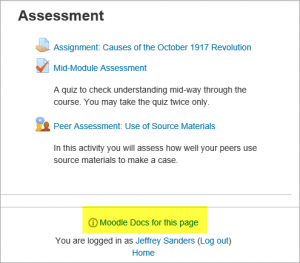Header and footer: Difference between revisions
Jeff Jensen (talk | contribs) |
Jeff Jensen (talk | contribs) m (→Moodle Docs) |
||
| Line 21: | Line 21: | ||
If the Moodle Docs document root field is left blank, no "Moodle Docs for this page" links will appear. | If the Moodle Docs document root field is left blank, no "Moodle Docs for this page" links will appear. | ||
[MoodleDocsforthispageScreenshot.png Sample Screenshot showing Moodle Docs for this page] | [[File:MoodleDocsforthispageScreenshot.png|300px|thumb|center|Sample Screenshot showing Moodle Docs for this page]] | ||
You may find that teachers prefer the documentation to open in a new window, so they can easily return to their page in Moodle. If so, click the "Open in new window" checkbox. | You may find that teachers prefer the documentation to open in a new window, so they can easily return to their page in Moodle. If so, click the "Open in new window" checkbox. | ||
Revision as of 02:17, 13 March 2013
Additional HTML
An administrator can add additional HTML to every page in Settings > Site administration > Appearance > Additional HTML.
These settings allow you to specify HTML that you want added to every page without altering the Moodle code files.
You can add HTML will be added within the HEAD tag for the page, immediately after the BODY tag has been opened, or immediately before the body tag is closed.
Doing this allows you add custom headers or footers on every page, or add support for services like Google Analytics very easily and independent of your chosen theme.
Moodle Docs
Moodle Docs is an abbreviation for Moodle documentation.
By default, managers, teachers and non-editing teachers (and any other users with the capability moodle/site:doclinks) have "Moodle Docs for this page" links at the bottom of each page in Moodle for accessing context-specific documentation.
An administrator can change Moodle Docs settings in Settings > Site administration > Appearance > Moodle Docs.
The default path is to docs.moodle.org. If a user has selected a language for which there is documentation available, the "Moodle Docs for this page" links will link to the documentation in that language.
If the Moodle Docs document root field is left blank, no "Moodle Docs for this page" links will appear.
You may find that teachers prefer the documentation to open in a new window, so they can easily return to their page in Moodle. If so, click the "Open in new window" checkbox.
As you may have discovered, Moodle Docs contains many searchable pages which represents 1,000s of hours of refinement by the Moodle community. For example, it is common to see a link from a forum in Moodle.org to a specific page or section in a Moodle Docs page. Likewise, something can be added to Moodle Docs to cover a new feature or to give a more detail description of a process that is not possible or desirable in a forum or as part of the help files.
Moodle Docs is a living document that is constantly changing at docs.moodle.org . Anyone in the Moodle community who sees a need is invited to make an addition or add their opinion in the page comments tab.
- Tip: If your site language is one for which there is unmaintained documentation (see Moodle Docs overview) e.g. Czech and you wish to make use of the archived documentation, you can set the Moodle Docs document root to https://docs.moodle.org/archive.
